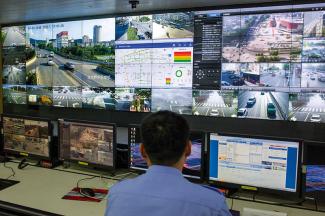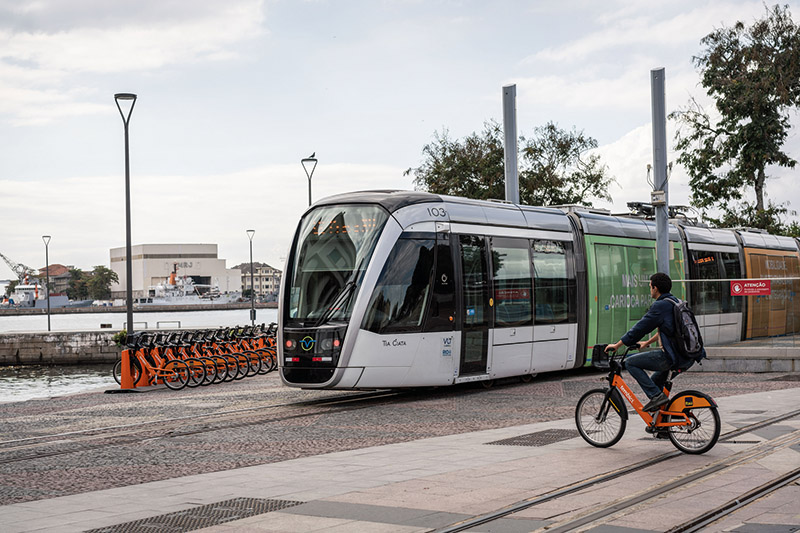KfW
Time for change – but how?

Most people around the world don’t have access to mobility options that meet their needs. Commuters spend hours in endless traffic jams; alternative forms of public transport are often not available, while well-linked and well-synced networks are a mere pipe dream. In Sao Paulo, for instance, traffic jams can stretch over 300 kilometres on peak days. Poorer people are forced to rely on expensive mini-buses that don’t link up to existing transport systems and tend to be unfit for the road. A simple journey to work can therefore become an arduous and time-consuming exercise – as well as a daily risk for many women due to the potential for sexual assault.
As well as dealing with the direct costs involved (over-inflated ticket prices), travellers ultimately face lost time and economic losses. In the Cairo metropolitan area, traffic jams generate annual estimated costs of around EUR 8 billion – and then there are the indirect losses caused by traffic accidents and respiratory problems. In India alone, around one million people die every year as a result of diseases related to poor quality urban air.
While more and more large cities in Asia and Latin America are implementing their own underground rail networks, bus systems and even cable cars, there is still a great deal of pent-up demand in Africa, particularly in the Sub-Saharan region. Local public transport in this area still consists almost exclusively of mini-buses and (shared) taxis. Only Addis Ababa in Ethiopia has a tram network (built three years ago), while Dar es Salaam in Tanzania has had a modern Bus Rapid Transit (BRT) system for the past two years. BRT networks are also at various stages of development in a number of other major cities, such as Dakar (Senegal), Lagos (Nigeria), Nairobi (Kenya) and Kampala (Uganda).
So, despite the fact its population is set to undergo heavy growth in the next few decades, Africa is still limping along behind developments in Latin America. Countries there began creating special bus lanes and adding bus stops over 20 years ago, thus developing an effective, safe and convenient transport system. However, these BRT networks are now stretched to their limits in some cities, like Quito and Lima. These cities are now pumping additional funds into larger, rail-linked systems.
Since underground networks are expensive, difficult to plan and tricky to construct, solutions known as light railways (overground urban railways or trams) are seen as an interesting addition or alternative. Cities in India are also looking increasingly to these options. This type of railway network is also gaining ground in Tunisia (Tunis) and Brazil (Rio) – thanks to KfW support.
Whatever solution cities opt for, one thing is clear: developing countries and emerging economies need more mobility, not less. Simply building an ever-growing number of new lanes and ring roads is not the answer either. After all, these soon reach their limit in terms of strain on people and the environment.
Even now, around 25 per cent of all energy-relevant carbon emissions can be traced back to traffic. Mobility options therefore have to be expanded on a sustainable basis.
Climate protection is just one of the reasons why the age of the combustion engine is coming to an end in industrial countries. All major vehicle manufacturers are currently rushing to advance and expand their electric vehicle ranges. On top of this, there is also the topic of autonomous driving, which is due to start growing in 2025 thanks to digital development. As our system of values is shifting more towards a “sharing economy”, it is becoming easier to say goodbye to our own vehicles, ultimately encouraging the development of electrically powered vehicles that link and mix the concepts of public and individual transport.
However, these trends cannot simply be transferred directly to developing countries and emerging economies – not least due to the lack of power and effective infrastructure for charging electric vehicles. Most countries will have to wait years before electric-based individual transport becomes available to the mass market. Until that point, other solutions are needed to resolve mobility problems in emerging and developing countries, particularly in light of the huge wave of urbanisation currently approaching many cities in these areas.
A resolute strategy of expansion for planned and integrated public transport networks is therefore crucial for these countries. To make sure this comes about, KfW will be stepping up its work with its partner countries in future. The actual options available vary from city to city; there is no “one size fits all” answer.
Solutions need to be based around factors like size, settlement structure, urban topography and the city’s level of economic development. While suburban railways and underground trains are likely to be crucial for coping with traffic levels in megacities over the long term, smaller cities could also fare well with (energy-efficient) buses or cable cars. However, efficient and effective bus systems may also be a sensible initial (interim) response in larger cities.
This is why sound planning is particularly important so as to allow the various means of transport to be brought carefully in sync with one another and incorporate non-motorised forms of transport. How do people get to the suburban railway stations? Where can they park their bikes? While these questions may seem minor, they can be decisive in determining whether sustainable forms of transport are used or not in cases of doubt. Lots of routes around cities aren’t much longer than a few kilometres. If the infrastructure is in place, these journeys can easily be completed on foot or by bike.
Digitalisation also offers huge potential for new solutions. Traffic control systems, city toll roads, electronic bike rental services and apps can help to bring modes of transport in line with one another – and this is just the beginning in terms of how the digital world can change mobility patterns. And these solutions are often affordable and easily implemented, as well.
For KfW Development Bank, this means increasing its investments in public transport in future and promoting non-motorised, energy-efficient or electric drive systems – while keeping a firm eye on the future and all the potential systematic changes it holds.
Link
KfW supplement in D+C/E+Z
https://www.kfw-entwicklungsbank.de/PDF/Download-Center/PDF-Dokumente-Medienkooperation-mit-E-Z/2018_10_NachhaltigeMobilität_EN.pdf












